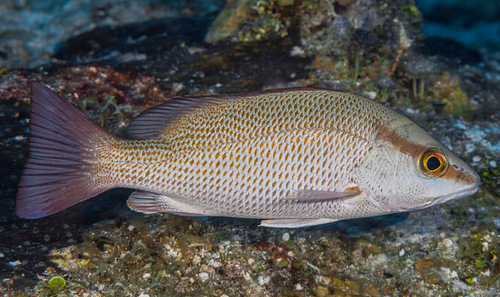
Gray Snapper
The Atlantic Bluefin Tuna (Thunnus thynnus) is a highly migratory, large pelagic fish famed for its size, speed, and commercial value. This top predator plays a crucial role in the marine ecosystem, and its life history is marked by long migrations and complex behaviors.
4 38 years
Lifespan
40 - 60 cm
Length
Least Concern
Conservation Status
15 km/h
Swimming speed
Carnivorous
Diet
Local Migration
Migration
Appearance Overview
The Atlantic Bluefin Tuna is renowned for its large, streamlined body, built for speed and endurance. It has a metallic dark blue back and a silvery-white underside.
Color
Dark metallic blue on top, silvery-white underside
Body Shape
Torpedo-shaped, streamlined
Fins
Two dorsal fins, the first depressible; a series of small finlets behind the second dorsal and anal fins
Length
Up to 13 feet (4 meters)
Weight
Up to 2,000 lbs (907 kg)
Diet
Carnivorous, feeding on a variety of fish, squid, crustaceans, and occasionally on seaweed and eelgrass.
Feeding Behavior
Highly active predator, using its speed and agility to hunt. Bluefin tuna often hunt cooperatively, herding and trapping prey fish.
Social Behavior
Forms large schools, especially during migration and spawning. Schools can be mixed with other tuna species.
Commercial Relevance
Extremely high value, particularly in sushi and sashimi markets, where its fatty flesh is considered a delicacy.
Conservation measures
Subject to strict international fishing quotas, fishing gear restrictions, and monitoring programs. Marine protected areas also play a role.
Status
Endangered
Threats
Overfishing (historically the primary threat), bycatch in fishing gear, habitat degradation, and climate change affecting prey distribution.
Habitat Distribution
Depth Range
0-1,000 meters (typically in the epipelagic and mesopelagic zones)
Geographic Range
Western and Eastern Atlantic Ocean, Mediterranean Sea
Preferred Environment
Temperate and subtropical waters; open ocean, often near continental shelves and slopes
Reproduction and Life Cycle
Breeding Habits
Spawns in warm waters, with two main spawning grounds: the Mediterranean Sea and the Gulf of Mexico. Spawning typically occurs in spring and summer.
Development Stages
Eggs hatch into larvae within days. Larvae are planktonic and undergo rapid growth, developing into juveniles and eventually adults.
Fecundity
Highly fecund; females can produce up to 30 million eggs per spawning season.
Maturity Age
Reaches sexual maturity at around 4-8 years, although this can vary between populations.
Faqs about Gray Snapper
How long do Atlantic Bluefin Tuna live?
Atlantic Bluefin Tuna can live up to 40 years, though this is becoming increasingly rare due to fishing pressure.
How fast can Atlantic Bluefin Tuna swim?
They are among the fastest fish in the ocean, capable of bursts of speed up to 43 mph (70 km/h).
Can I eat Atlantic Bluefin Tuna?
Yes, but it's crucial to ensure it comes from a sustainable and legally caught source due to their endangered status.
Are Atlantic Bluefin Tuna warm-blooded?
They are warm-blooded, which is rare among fish. This allows them to maintain a higher body temperature than the surrounding water, aiding in muscle efficiency.
Do they migrate?
Bluefin tuna undertake extensive migrations across the Atlantic Ocean, often traveling thousands of miles for feeding and spawning.
What is the biggest Bluefin Tuna ever caught?
The largest recorded Atlantic Bluefin Tuna weighed approximately 2,000 lbs (907 kg).
Where can I find Atlantic Bluefin Tuna?
They are found in both the western and eastern Atlantic Ocean, as well as the Mediterranean Sea.
Why are they endangered?
Overfishing has severely depleted their populations, and international regulations are in place to manage their catch.
What do they eat?
They primarily eat smaller fish, squid, crustaceans, and occasionally seaweed.
How do they reproduce?
Females can release millions of eggs during spawning, which are then fertilized externally by males.
Copyright @ Nature Style Limited. All Rights Reserved.
 English
English